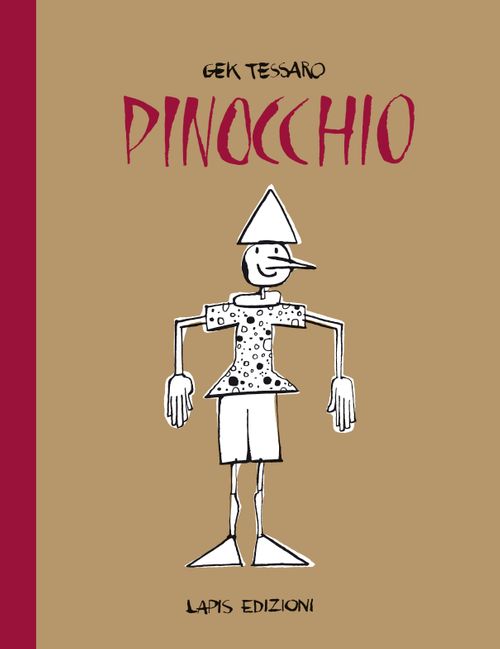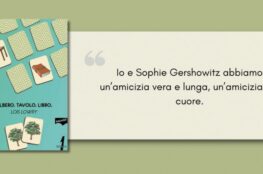Il Pinocchio di Gek Tessaro
Tra gli ospiti più amati e seguiti di questa 11° edizione del Buck Festival – Festival della Letteratura per ragazzi di Foggia – tutta dedicata ai classici, c’è Gek Tessaro, che propone il suo Pinocchio.
Il libro Pinocchio, edito da Lapis Edizioni (2017), è un bel volume corposo, con la copertina rigida di carta “grezza”. Ricorda i vecchi testi rilegati a mano con carta da pacchi, quelli che poi le madri abbellivano con qualche piccola decorazione. È una rivisitazione audace, per alcuni versi irriverente, del Pinocchio che tutti conosciamo e tutti abbiamo amato.
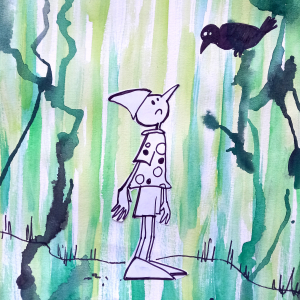
Il Libro
Pinocchio, di Gek Tessaro, Lapis, 2017.
L’autore osa una riscrittura della storia tra le più note al mondo, e si prende la libertà di cambiarne il finale. Non taglia nulla dell’originale. Tessaro lima e “asciuga” il testo da tutto quello che potrebbe rendere le vicende del burattino lontane dai noi e dal nostro presente. Un’operazione discutibile, forse per alcuni irrispettosa, che certamente crea stupore e qualche perplessità tra gli amanti dei classici o tra i lettori meno giovani.
Molti giganti l’hanno illustrato, ma avendo un minimo di pudore e di rispetto si sono ben guardati dall’intervenire sul testo. Il risultato (e qui azzardo un’ipotesi temeraria e forse discutibile) è che poi si osservano, si amano le figure, ma si sorvola su quel che sta scritto.
Tratto da “Metto le mani avanti”, la premessa di Tessaro al suo Pinocchio
L’autore rende la narrazione aderente al tempo che abitiamo. Tessaro cuce il racconto addosso ai suoi lettori più piccoli in modo che la storia arrivi presto. In modo che arrivi dritta e tutta intera. Senza colpe da espiare e malefatte da punire, e che resti impressa.
La prima volta che l’ho letto, di tutte le sciagure che lo vedevano protagonista, quella che più mi ha colpito è stata l’immagine finale del burattino, morto, buttato su una sedia, rinnegato e deriso dal nuovo Pinocchio. […] La trasformazione di Pinocchio in ragazzo ha un costo altissimo: la perdita di sé, la sua identità. […] Così, di fronte a questo ragazzo bello, ricco, e ubbidiente, che è appena comparso e già sembra insopportabile, mi sono preso il privilegio di liberare Pinocchio dalla necessità di essere “normale”. Come tanti lettori, anch’io ho spesso desiderato poter intervenire in favore del mio eroe. E l’ho fatto.
Questo è un libro che ha spessore e bellezza in sé e in questo senso va considerato. Non va giudicato nel confronto con il Pinocchio “originale”, ma in quanto opera nuova.
Gek Tessaro
Tessaro “parteggia”, si schiera, cosa che pochi sembrano saper fare ultimamente. Senza mediare si assume la responsabilità di stare dalla parte del burattino, sottrae alle sua sorte la colpevolizzazione, le mortificazioni, il confronto – che lo vedeva perdente – tra un pezzo di legno rigido, sciupato e sporco, e un bambino vero, con la carne rosea, morbida e fresca, e decide da che parte stare, consapevolmente: Pinocchio resta burattino.
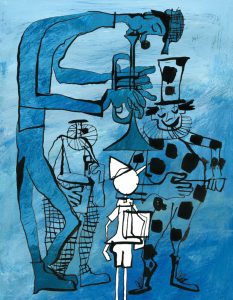
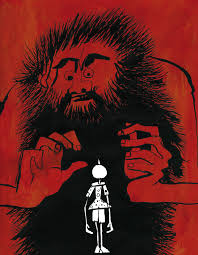
Pinocchio rivoluzionario
È un Pinocchio rivoluzionario e poetico, questo di Tessaro. Un Pinocchio rivoluzionario non solo nella rivisitazione del testo, ma anche nell’illustrazione: nelle immagini a colori o in quelle in chiaro scuro, il burattino è sempre bianco, come una sagomina di carta ritagliata e posta su uno sfondo sempre diverso, che non gli appartiene del tutto. Forse perché è unico, è diverso da tutti e il contesto nel quale di volta in volta capita non scalfisce la sua essenza. Le sue mani, poi, sono decisamente grandi, quasi sproporzionate. Sono delle manone accoglienti e vibranti, ché forse è proprio con quelle che scegliamo, schiviamo pericoli, ci proteggiamo, costruiamo il nostro destino.
Quel che arriva a noi è un’immagine certamente diversa dal Pinocchio a cui siamo abituati. Un Pinocchio altro, che però non ha perso niente della sua identità e che non fatichiamo a riconoscere.
Lo spettacolo
Il Pinocchio di Gek Tessaro è anche uno spettacolo teatrale per piccoli e grandi, con la regia dello stesso autore insieme a Lella Marazzini, sua compagna nella vita e nell’arte. In scena, sul palco, di fronte a platee ricche di bambini di tutte le età, Pinocchio esce finalmente dalle pagine. La narrazione e le immagini si fondono e il racconto prende corpo.
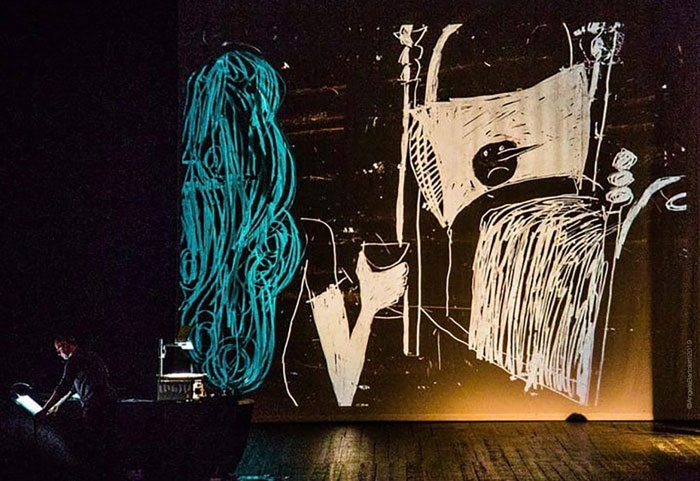
La poesia dei suoi disegni dal vivo, l’emozione del gesto nel momento stesso in cui nasce e diventa segno, la musica che al gesto si fonde, la presenza in scena dell’autore che con mani agili e sicure crea i personaggi, restituisce vita e tridimensionalità a una delle fiabe più belle di tutti i tempi.
Lo spettacolo di Gek Tessaro, è anche un omaggio a Fiorenzo Carpi, autore della colonna sonora delle indimenticabili Avventure di Pinocchio, di Comencini.
Le figure, realizzate su una lavagna luminosa con tecniche pittoriche diverse, sono le protagoniste assolute della performance, e creano un’atmosfera magica dentro la quale lo spettatore si perde.
Siamo grati a chi compie gesti intellettualmente coraggiosi. Sono queste piccole ribellioni pacifiche che incidono su modi di pensare consolidati e che mutano con delicatezza il modo in cui ci approcciamo alle cose.
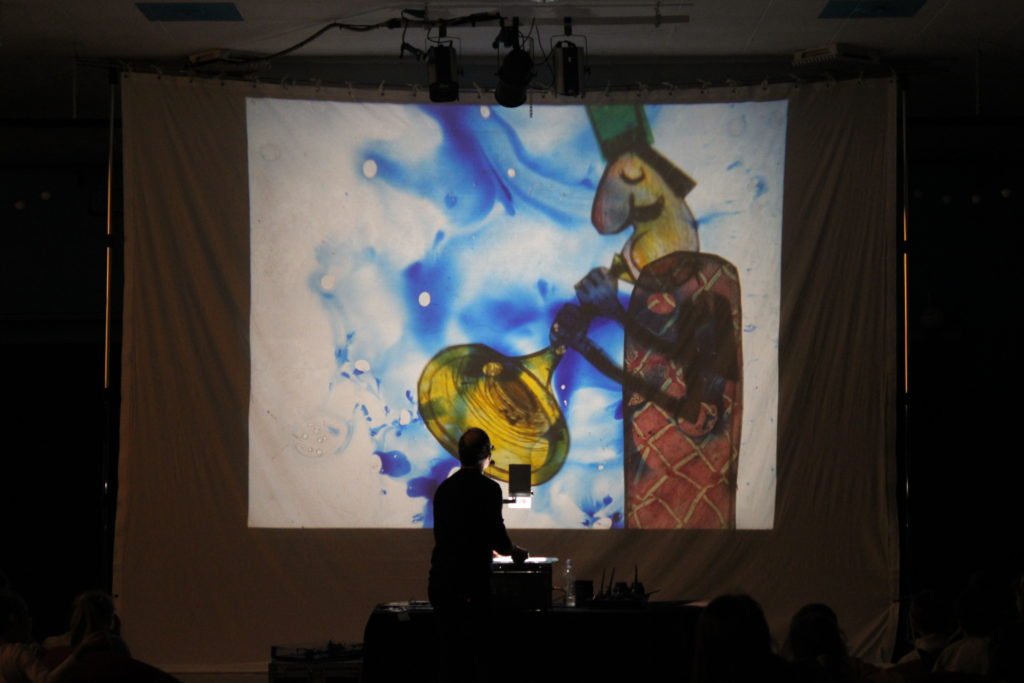
Pinocchio never dies
The fate of Pinocchio according to Gek Tessaro
Among the most loved and followed guests of this 11th edition of Buck Festival – Literature festival for children of Foggia – entirely dedicated to classics, there’s Gek Tessaro that presents his Pinocchio.
Edited by Lapis Edizioni (2017), the book is a quite substantial volume, with the hardcover formed by a “raw” paper, that recalls the old books with the handmade binding by using the wrapping paper, then embellished by mothers with some small decorations. It is a bold, sometimes insolent reinterpretation of Pinocchio, that we all know and we all loved.
The book
The author dares to rewrite the story among the most popular all over the world, and takes the freedom to change the end. He does not cut anything from the original, but reduces and “dries” the text of all the things that could make the puppet’s events far from us and from our present. A questionable operation, maybe disrespectful for someone, which has certainly created astonishment and some doubts among the lovers of classics and the older readers.
As Tessaro himself tells us in his introduction to the book, with the significant title Metto le mani avanti (in english: I put my hands forward):
Lots of Masters have illustrated it, but having a minimum of modesty and respect, they have carefully refrained from intervening on the text. The result (and here I make a rash and perhaps questionable hypothesis) is that sometimes we observe, we love the figures, but we overlook what is written.
So, it seems that the necessity of the author is to make the narration appropriate for the time we live in, sewn on our younger readers but also on who deals with children, so that this story arrives soon, arrives straight and whole, without sins to atone for and wrongdoings to punish, and that it remains etched.
The first time I read it, among all the disasters that saw him as the protagonist, the one that struck me most was the final image of the puppet, dead, thrown on a chair, denied and mocked by the new Pinocchio. […] The transformation of Pinocchio into a boy has a very high cost: the loss of himself, his identity. […] So, in front of this handsome, rich, and obedient boy, who has just appeared and already seems unbearable, I took the privilege of freeing Pinocchio from the necessity to be “normal”. As lots of readers, I have often wished I could intervene in favor of my hero, too. And I did it.
This is a book that has substance and beauty in itself and in this sense it must be considered. It has not to be judged compared with the original Pinocchio, but as a new work.
Gek Tessaro
Tessaro takes sides, something that few people seem to be able to to do recently, and without mediating he assumes the responsibility of being on the puppet’s side, he takes away from his fate the blame, the mortifications, the confrontation – which saw him as a loser – between a rigid piece of worn and dirty wood, and a real child, with pink, soft and cool flesh, and consciously decides which side to be on: Pinocchio remains a puppet.
Pinocchio by Tessaro is a revolutionary and poetic one, not only in the reinterpretation of the text, but also in the illustration: in the colored images or in the light and dark ones, the puppet is always white, like a paper shape cut out and placed on an always different background, which does not entirely belong to him. Perhaps because it is different from everyone else, it is unique, and the context in which from time to time it ends up will not scratch its essence. Then, his hands are noticeably large, almost disproportionate, comfortable and vibrant hands, because perhaps it is precisely with those that we choose, we avoid dangers, we protect ourselves, we shape our destiny.
What comes to us is an image that is certainly different from the Pinocchio we are used to, but which has lost nothing of its identity and which we do not struggle to recognize.
The show
Pinocchio by Gek Tessaro is also a theatrical show for children and adults, directed by the same author together with Lella Marazzini, his partner in life and art. During the performance, on the stage, in front of audiences full of children of all ages, Pinocchio finally arises from the pages, so narration and image mingle together and the story takes shape.
The poetry of his live drawings, the emotion of the gesture at the very moment in which it comes into the world and becomes a sign, the music that blends with the gesture, the presence on stage of the author who with agile and confident hands creates the characters, restores life and three-dimensionality to one of the most beautiful fairy tales of all time. It is an emotional journey that also becomes a tribute to Fiorenzo Carpi, author of the soundtrack of Comencini’s unforgettable Pinocchio.
The figures, produced on an overhead projector with different painting techniques, become original and strange sets and, at the same time, are the absolute protagonists of the performance, and create a magical atmosphere in which the viewer gets lost.
We are grateful to those who make intellectually courageous gestures. These small peaceful rebellions weigh on established ways of thinking and lightly change the way we approach things.

